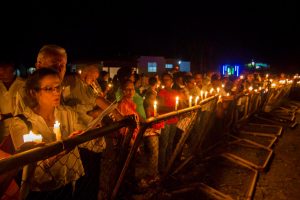
As Haiti and the Dominican Republic clean up from the aftermath of Hurricane Matthew, this week commemorates another tragedy: the Parsley Massacre, an ethnic cleansing in early October 1937 on the border of the two islands sharing the island of Hispaniola.
In my first book, Why the Cocks Fight: Dominicans, Haitians, and the Struggle for Hispaniola, I wrote about how Dominican soldiers are said to have asked people on the border to pronounce the Spanish word for parsley; if they had trouble trilling the “r,” they were killed.
Rita Dove’s poem, entitled Parsley in reference to that story, powerfully evokes the massacre.
The tragedy has produced other powerful works of literature, film, and creativity.
Farming of Bones is the Haitian-American author Edwidge Danticat’s novel of star-crossed lovers set against the backdrop of the massacre.
More recently, the Dominican-American poet and novelist Julia Alvarez published A Wedding in Haiti, a memoir of her friendship with a young Haitian man named Piti.
I met Julia in 1999 after my publisher sent her an advance copy of Why the Cocks Fight. She sent me a lovely note with a hand-made card with a photograph of a cockfight on the front, beginning a long friendship between two authors who hold a certain island dear in their hearts.
A few years later, Julia and talked over lunch about how sad it was that there had been no “truth commission” or other formal recognition of the victims and survivors of the massacre. We talked about how wonderful it would be to hold a candlelight vigil at the border in their honor. This was before the Internet could bring people together the way it does today, and life (as it has a habit of doing) got in the way of turning the idea into reality.
But in 2011, after the death far too soon of the Dominican-Haitian activist Sonia Pierre, a group of young Dominican- and Haitian-Americans approached us about reviving the idea of a border vigil to both honor Sonia’s memory and memorialize the massacre.
Thus was born Border of Lights, an arts collective driven by rising new voices from the diaspora, that launched in 2012 in the weeks leading up to the 75th anniversary of the massacre. Border of Lights convened performances ofmonologues from the perspectives of victims, survivors, perpetrators, and bystanders, and collected personal narratives that are still hosted on its website.
Border of Lights will hold a Global Vigil this Saturday, October 8, from 8-10pm Eastern Time, with a real time Facebook Q&A about the historical legacy and the way it has played into today’s issues. Border of Lights invites friends around the world to post photos of themselves with candles or other lights to its Facebookand Twitter accounts with the hashtag #BeLights.
From October 7-9, Border of Lights volunteers and partners will hold a vigil on the actual border and clean up after the storm. They also will screen a new film, Death by a Thousand Cuts, a powerful tale of how border tensions play out in a life and death drama over deforestation and the illicit charcoal trade from the Dominican Republic to Haiti. The film premiered at Toronto’s Hot Docs Film Festival in May.
The annual vigil, which celebrates the positive elements of the two countries’ relationship, continues even after tensions rose to new heights after a 2013 Dominican high court decision revoking the citizenship of many Dominicans of Haitian descent, and the exodus that followed after the government began enforcing it in 2015. The Dominican government revoked an award it had given to Dominican-American author Junot Diaz because he, like many other writers, artists, and scholars, had spoken out against its harsh policies.
The massacre and its modern-day legacy also have informed scholarship on the fraught relationship between the Dominican Republic and Haiti.
In The Tears of Hispaniola: Haitian and Dominican Diaspora Memory, the Cuban-American scholar Lucia Suarez shows how the writing of diaspora Dominicans and Haitians has shed new light on both the past and present tensions. She ties their work to the historical record by drawing as well on texts like human rights reports.
Two new books published in 2016 by a new generation of Dominican-American scholars add new insights to the long-running issues of race, nationalism, and violence.
Borders of Dominicanidad: Race, Nation, and Archives of Contradiction, by the Harvard scholar Lorgia Garcia Pena, comes out in November.
Edward Paulino, a historian at John Jay College and a co-founder of Border of Lights, published Dividing Hispaniola: The Dominican Republic’s Border Campaign against Haiti, 1930-1961 in January.
Together, these works serve to recognize the memory of the victims and survivors of the massacre, and to work toward the hope that such an atrocity is never repeated. At a time when racist and nationalist speech is enjoying a resurgence around the world, this creative outpouring is more important than ever -both on the island of Hispaniola and everywhere that hatred raises its ugly head.